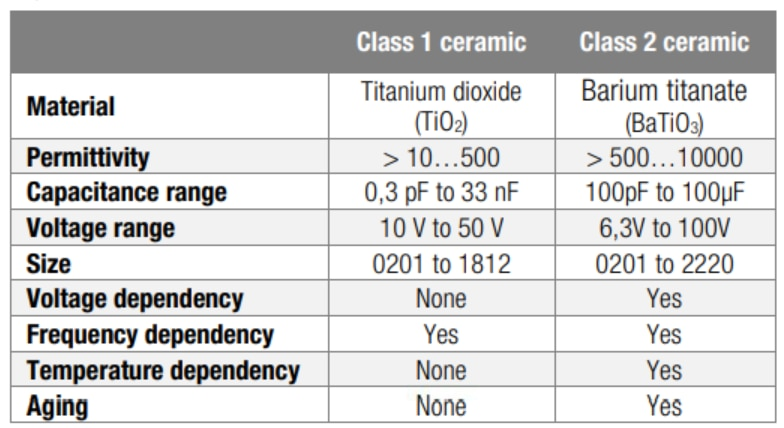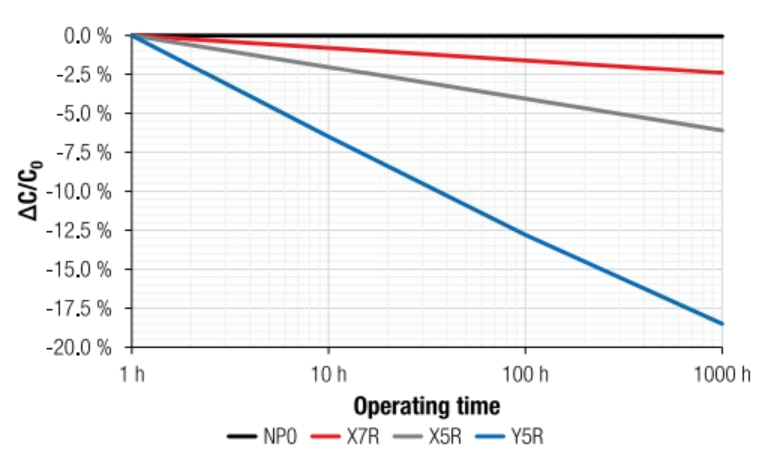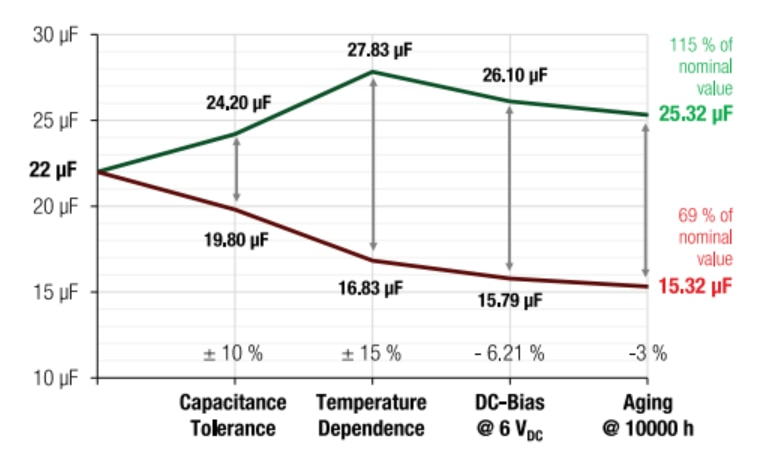
- +86 18120750932
- colin@xmsinuowei.com
- th.xmsinuowei.com

1 ภาพรวมเกี่ยวกับ Class 1 และ Class 2 MLCCs?
โดยพื้นฐานแล้ว MLCCS สามารถแยกความแตกต่างได้สองประเภท: ตัวเก็บประจุซึ่งสร้างจากเซรามิกคลาส 1 หรือคลาส 2 สิ่งเหล่านี้แตกต่างกันไปในหลาย ๆ ด้านดังแสดงในตารางที่ 1

ตารางที่ 1: ภาพรวมของสถานะทางเทคนิคในปัจจุบันของเซรามิกส์ของ Würth Elektronik eiSos
คุณสมบัติและความคลาดเคลื่อนของคลาสเซรามิกต่างๆ ถูกกำหนดโดยรหัส IEC หรือ EIA ขึ้นอยู่กับแอพพลิเคชั่น ต้องมีความจุจำนวนหนึ่งเพื่อให้ได้ประสิทธิภาพที่ต้องการในแอพพลิเคชั่นเช่นตัวกรอง ดังนั้นจึงเป็นเรื่องสำคัญที่จะต้องเปรียบเทียบคุณสมบัติของแต่ละส่วนประกอบเพื่อให้แน่ใจว่ามีลักษณะการทำงานที่ต้องการเมื่อใช้ในแอปพลิเคชัน ควรจะกล่าวถึงด้วยว่า MLCCs ที่มีความจุสูง ความจุสูงนั้นใช้ได้เฉพาะกับข้อเสียของอายุที่มากขึ้นเท่านั้น จึงทำให้สูญเสียความจุมากขึ้นเนื่องจากอุณหภูมิและแรงดันไฟฟ้า
2 นิยามของความชรา
ความชราเป็นกระบวนการที่คุณสมบัติบางอย่างเปลี่ยนแปลงไปตามกาลเวลา วัสดุเฟอโรอิเล็กทริก เช่น แบเรียมไททาเนตก็อยู่ภายใต้กระบวนการนี้เช่นกัน โครงสร้างผลึกของอิเล็กทริก (ในกรณีนี้คือแบเรียมไททาเนต) เปลี่ยนแปลงตามอุณหภูมิและเวลาด้วย สิ่งนี้ถือเป็นการเสื่อมสภาพเนื่องจากความจุเปลี่ยนแปลงหรือที่แน่นอนกว่านั้นก็คือ ลดลงจากเหตุการณ์นี้ ผลอีกประการหนึ่งของอายุที่เพิ่มขึ้นคือการสูญเสียปัจจัยที่เพิ่มขึ้นซึ่งจะมีขนาดใหญ่ขึ้นเรื่อย ๆ การเสื่อมสภาพมักจะอธิบายโดยการสูญเสียความจุเป็นเปอร์เซ็นต์ต่อทศวรรษของเวลา อยู่ในช่วง ~6% หลังจาก 1,000 ชั่วโมงสำหรับเซรามิก X5R และ ~2.5% หลังจาก 1,000 ชั่วโมงสำหรับเซรามิก X7R ต่อทศวรรษชั่วโมง (1-10, 10-100, 100-1000, ...) หลังจากปรับแนวคริสตัลแลตทิซ (เช่น โดยกระบวนการอุณหภูมิที่สามารถทำซ้ำได้บ่อยเท่าที่ต้องการ) การเสื่อมสภาพจะนำไปสู่การสูญเสียความจุดังแสดงในรูปที่ 1 กระบวนการชราภาพเป็นลอการิทึมและลดลงตามเวลา แม้ว่าจะปรากฏเป็นเส้นตรงบนแผนภูมิเมื่อใช้สเกลลอการิทึม

รูปที่ 1: การสูญเสียกำลังการผลิตเทียบกับเวลาในการทำงาน
3 ทำไมแบเรียมไททาเนตจึงมีอายุมากขึ้น
การอนุญาตของแบเรียมไททาเนตถูกกำหนดโดยความสามารถในการเกิดขั้วของวัสดุ โดเมนเฟอโรอิเล็กทริกอื่นๆ เกิดจากอายุที่มากขึ้น ทิศทางโพลาไรเซชันที่เกิดขึ้นเองจะเปลี่ยนในลักษณะที่ไดโพลทั้งหมดไม่สามารถโพลาไรซ์ได้ "ดี" ไดโพลของสองโดเมนที่อยู่ติดกันจะไม่ชี้ไปในทิศทางเดียวกันอีกต่อไป ผลที่ได้คือความจุลดลง วิธีแก้ปัญหา: การปฏิรูปวัสดุ ผลกระทบของการเสื่อมสภาพได้รับอิทธิพลจากเวลา อุณหภูมิ และแรงดันไฟฟ้า เนื่องจากแบเรียมไททาเนตเป็นวัสดุเฟอร์โรอิเล็กทริกและมีโดเมนทางไฟฟ้า เช่นเดียวกับเฟอร์ไรต์ โดเมนเหล่านี้จึงหารด้วยแฟกเตอร์ไทม์ และทำให้ความจุลดลง โปรดดูรูปที่ 2

รูปที่ 2: การเปลี่ยนแปลงโครงสร้างภายใน
By tempering, the so-called preheating process (heating the material above the Curie temperature), the existing domains dissolve. Below the Curie temperature, the material then forms new large domains again, which in turn results in a high capacity. The thermal movement in the crystal lattice caused by the annealing process prevents the dipoles from aligning completely when an electric field is applied, thus reaching a kind of saturation.
4 How can aging be stopped?
The dielectric used in Class 2 MLCCs has ferroelectric properties. These material properties change when the Curie temperature is exceeded (as with ferromagnetic materials). Above this temperature, the dielectric has a highly symmetrical cubic crystal structure, while below the Curie temperature; the crystal structure has a less symmetrical (tetragonal) structure. The transition from the different phases (cubic to tetragonal etc.) always results in a maximum value of permittivity over this temperature range. To achieve a stable state, the atoms in the crystal lattice move under the influence of thermal vibration for a long time, even after the dielectric has cooled down below the Curie temperature (more and more domains are formed). However, when the capacitor is heated to a temperature above the Curie temperature, aging takes place, i.e. the capacity lost due to aging is regained and aging begins again from the point at which the capacitor cools down again. This temperature is ~125°C for barium titanate. Depending on how long the Curie temperature is exceeded, this results in the capacitance value that is set. According to the data sheet, the recommendation for preheating at 150°C is 1 hour. By this thermal treatment, the maximum 100% capacity of the component can be restored.
5 Effects of aging for the application
In a real application, which contains voltage and is operated at a certain ambient temperature, a reduction in capacity over time must generally be foreseen when using MLCCs. This is unavoidable and is caused by the base material used for Class 2 ceramics. It is now up to the design of the capacitor to compensate for this capacitance loss. A 100% test is performed after manufacture to ensure that all tolerances are met. Depending on storage time and storage conditions, these values may change over time. Due to the heat influence of the soldering process, the aging process is reset (see appendix, example measurement and reflow soldering process for a MLCC with the DateCode 2014). In applications where stable capacitance values are required, aging must be considered or a Class 1 MLCC must be used. If capacitors are used as output capacitors (e.g. in switching regulators), the effect of aging can be best compensated for, as in this case the capacitance fluctuations are in the low single-digit range and therefore have no negative effect on the function of the circuit. The resulting capacitance of an e.g. 22 µF X7R MLCC with all dependencies is shown in figure 3.

Figure 3: Real capacity considering all dependencies
6 Conclusion
The aging is recorded at room temperature (around 20 °C) and ~0 V as applied voltage. At room temperature and ~0 V ceramic capacitors have almost no temperature, DC bias and frequency influences that could influence aging. Below the Curie temperature and after applying a voltage, the existing ferroelectric properties polarize the molecules in a defined manner. The cubic structure becomes a tetragonal structure, which leads to a decrease in permittivity and thus in capacity. What now leads to aging? If the crystal structure of the ceramic is left at room temperature without load, randomly oriented domains are formed in which, in turn, non-directional dipoles are formed, which have a negative influence on the permittivity. These randomly oriented domains "grow" faster at first and then develop more slowly. Therefore, the loss of capacity is shown logarithmically. When a voltage is applied and the temperature is increased, the formation of randomly oriented domains slows down, since the dipoles are aligned in a defined manner by the electric field. In practice, this means that aging as shown in Figure 1 is a “worst case” figure. Since the decrease in capacity via DC bias and temperature is significantly higher than the expected aging, this is assumed a fixed value.
Source:element

บริการออนไลน์